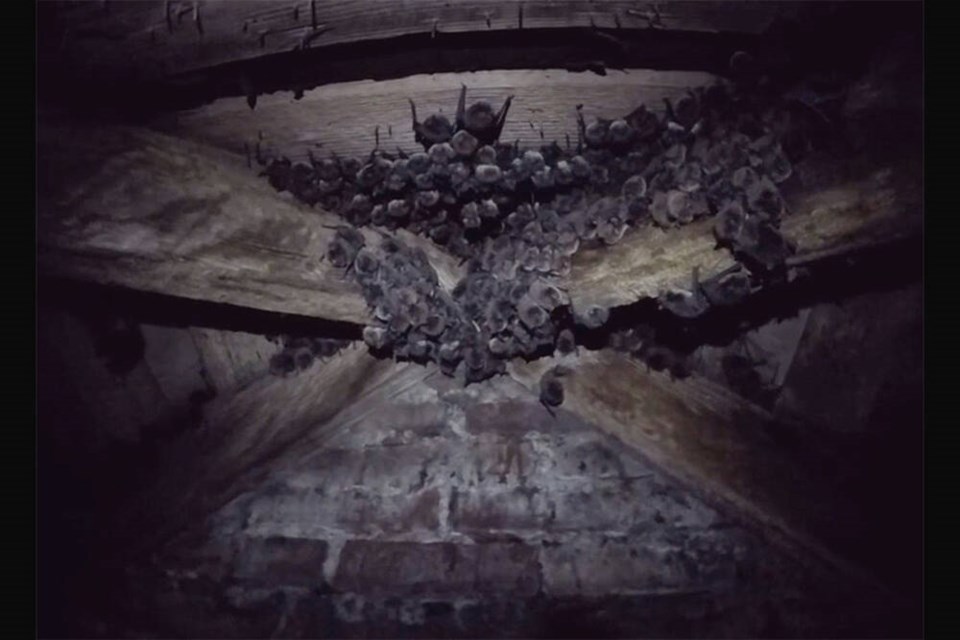Metro Vancouver hopes measures can protect the bat colony living in an historic Delta house from a threat that’s been detected in B.C. for the first time.
Located at Deas Island Regional Park, the Burvilla House, also known as the Burr Heritage House, is home to around 3,000 bats, mostly Yuma bats and little brown bats, the largest nursery colony of bats in B.C.
They rely on the habitat at the regional park and the surrounding area for food, mainly insects and thousands of mosquitoes.
Nine species have been detected in the house and the colony is monitored by Metro Vancouver and the South Coast Bat Society.
They have been in the house for around 20 years but monitoring increased in 2016 after it was found the colony grew significantly in the attic.
They now face a potential threat as the province this week announced that the fungus that causes white nose syndrome in bats has been detected in bat guano in the Grand Forks area.
Since the arrival of the fungus on the west coast of the United States in 2016, the province has been monitoring for its arrival in B.C.
The province notes that the Ministry of Water, Land and Resource Stewardship is working with multiple partners to implement enhanced surveillance for the disease, as well as reduce threats to bat habitat. Since bats eat a wide variety of insects and pests, they are essential for keeping B.C.’s ecosystems in balance.
The public is asked to contact the BC Community Bat Program or the Ministry of Water, Land and Resource Stewardship with any information on the location of winter bat roosting sites, unusual behaviour, such as flying during the day, and observations of dead bats.
Markus Merkens, Natural Resource Management Specialist for Metro Vancouver, told the Optimist that bat colonies within regional parks have been monitored for a number of years, and this year the regional district will once again issue a permit to the BC Community Bat Program to monitor and to collect guano from known colonies within the regional parks system, including at Deas Island Regional Park.
The guano will be sent to a lab for analysis to confirm species identification and detect the presence of white nose syndrome related pathogens, he said, adding that monitoring for white nose syndrome is the first step in managing its impact.
“Metro Vancouver has also been providing bat researchers connected with Wildlife Conservation Society Canada access to colonies in regional parks to test whether probiotic inoculations could be an effective means of protecting native bats from the effects of white nose syndrome. The society is working with researchers at Thompson Rivers and McMaster universities to develop a preventative approach based on naturally occurring soil bacteria that can help protect bats from the white nose syndrome fungus,” said Merkens.
The province notes that white nose syndrome was first discovered in New York state in 2006 and has spread to 38 states and eight provinces. The associated mortality is responsible for three Canadian bat species being listed as “endangered” under the federal Species at Risk Act.
The fungus is primarily spread by bat-to-bat contact. The fungus doesn’t affect humans, but people may spread fungus spores through the movement of contaminated clothing and gear, or through accidental translocation of bats.
Because there is currently no proven prevention or treatment for white nose syndrome, the best approach for bat conservation is the reduction of other threats to support healthy, resilient bat populations as they face this disease. Scientists are working together to better understand bat behaviour and habitat use in the winter when bats are most at risk from the fungus.
Anyone who discovers a sick or dead bat should never pick it up with their bare hands. The BC Community Bat Program has information about reporting a dead bat on its website, as well as tips to help protect British Columbia’s bat populations.
Visit the BC Community Bat Program at https://bcbats.ca/.



